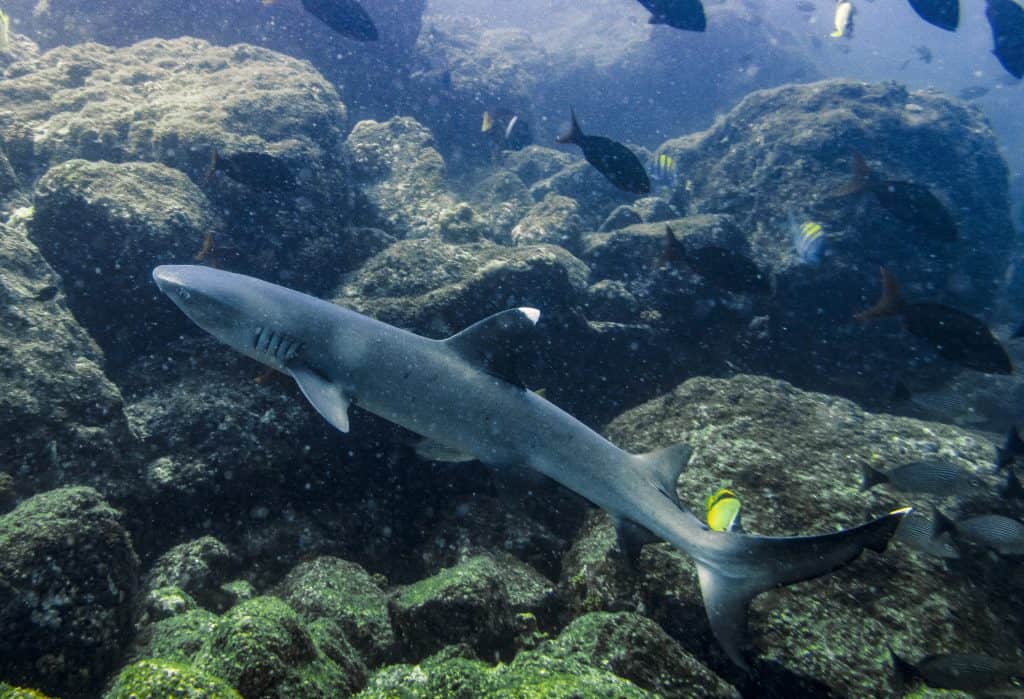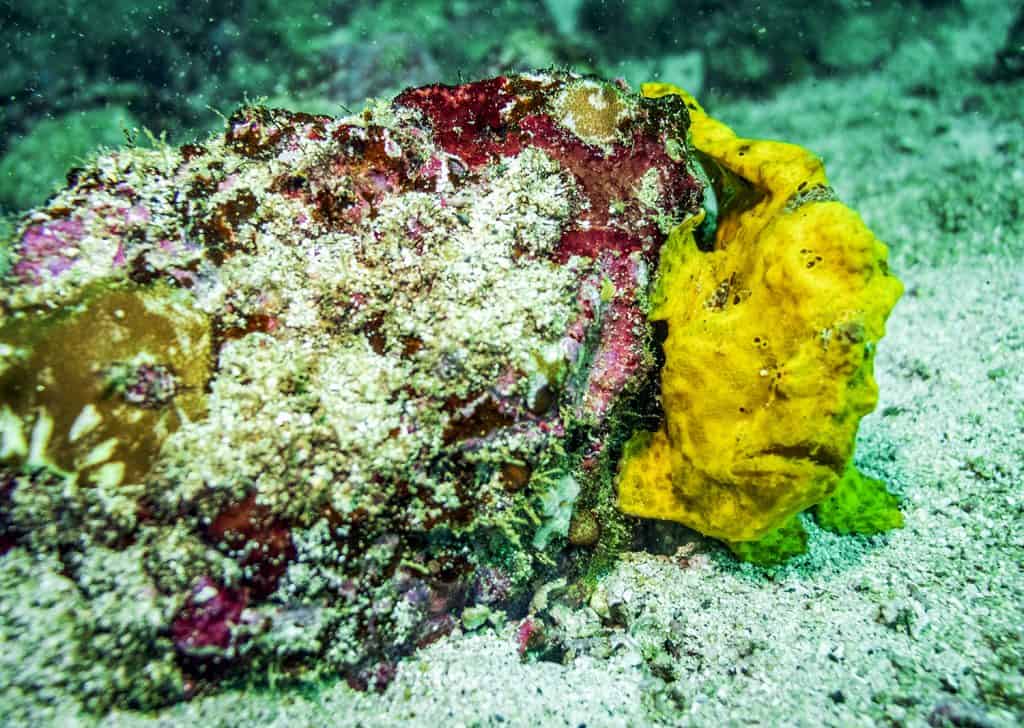Coiba Island has the widest variety of coral species, and you will be amazed by the impressive schools of fish, turtles, squid, eels, dolphins, whales, and much more, it’s really a top diving experience in Panama.
Huge schools of jacks, snapper, and barracuda ofter swim by the reefs. Other marine animals such as a healthy population of hammerhead sharks, bull sharks, giant manta rays, and whale sharks, the biggest fish in the world, can often be spotted in season within the safety of the reserve area. There are more than 800 marine species discovered in the waters surrounding the park.
Strong currents bring into the mix a lot of surprises – not as much on Coiba’s shore reefs as on numerous underwater pinnacles located either offshore or in the straits between the islets.
The pinnacles grant the best of Coiba diving, and tidal currents provide for real wonders in fish aggregation. Diving there can be utterly unpredictable; just see for yourself if it fits your concept of fun. During the same dive, the clear blue water can turn green.
Diving in Coiba National Park is a magical experience, is one of the world’s largest marine sanctuaries and a cornerstone of the Eastern Pacific Marine Corridor – an area of protected zones for migrating fish and mammals from Ecuador to Costa Rica offers the best diving and big fish encounter in Panama. The Lonely Planet calls it “the best diving…between Mexico and Colombia”.

It’s an Oasis in the middle of the ocean, this diversity of marine wildlife exists in this region due to the Humboldt Current which delivers cold, nutrient-rich water toward the surface that makes it possible to sustain the rich biodiversity.
The coral reef areas contained in the Coiba National Park area have been spared what is known as the El Niño bleaching effects, which occur as a result of warm water currents flowing into the coral reefs, such as around the Galapagos and Cocos Islands. , therefore, it offers the benefits of seeing a truly unspoiled and spectacular diving experience.
The isolation of the penal colony preserved the island’s pristine habitat. Although just 12 mi (20km) offshore in the Golfo de Chiriquí, Coiba is a veritable lost world of pristine ecosystems and unique fauna. It is these reasons that make Isla Coiba, Panama such a rare gem, and a hope spot for the world. Don’t lose the opportunity to dive into the Coiba National Park.
Explore Coiba Island and discover a breathtaking wild nature reserve with 80% of its territory is untouched by humans. The island is for the most part untouched, you can easily spot wildlife like crocodiles, monkeys, and macaws. Hiking possibilities are also available on the island.
This journey is unlike any other as you explore nature’s best along the Coiba and Veraguas coast, visiting the top diving spots of Panama. There is no doubt that Coiba is a living laboratory.
Even more spectacular is diving at the Hannibal Bank which is located farther offshore, due West, outside the Coiba National Park boundaries. Diving at Hannibal Bank can be as tricky as any open-ocean diving, totally pelagic environment, underwater mountains rising from thousands of feet/meters to 160 ft / 46 m, just out of recreational dive depth limits.
Running five miles long and three miles wide, the banks are characterized by deep water. In addition, they’re a beneficiary of the Humboldt Current that moves an abundance of plankton biomass to the surface. As a result, the bank’s prolific food chain delivers trophy-sized yellowfin tuna.
They’re just a few hot diving spots on Coiba’s surrounding water, like Cathedral Rock, Contreras Ridge, Fishermans Dream, Frijoles Ridge, Hannibal Banks, Hatched Rock, Hill Rocks, Isla Iglesias, Isla Ladrones, Isla Montuosa, Jacobs Ladder, Mona Lisa, Octopus Rock, Pyramids, Shark City, Shark Fin, The Fridge, The Monster, Twin Peaks, and Wahoo Rock.

Coiba’s Pacific tropical moist forest maintains exceptionally high levels of endemism of mammals, birds, and plants due to the ongoing evolution of new species. It is also the last refuge for a number of threatened animals such as the crested eagle. The property is an outstanding natural laboratory for scientific research and provides a key ecological link to the Tropical Eastern Pacific for the transit and survival of pelagic fish and marine mammals.
Spend a full day at sea watching for whales, dolphins, and sea turtles in the water or enjoy a range of outdoor active exploration on a choice of sightseeing, dive into cristal water of guided snorkeling in Granito de Oro and Canales de Afuera are places that the time forgot on remote tropical islands that are both isolated and awe-inspiring, discover wildlife found nowhere else on earth with insights provided by our crew, see endemic Coiba monkeys or rich underwater life while snorkeling.
It was emergent (above sea level) about 35 million years ago. Coiba Island and the area we refer to as the ‘Panama microplate’ was transported with the Cocos Plate to the subduction zone of Panama and Costa Rica, and then incorporated in the continental border, and was part of the mainland.
Coiba Island originated as one of the exotic terranes, like the Azuero and Soná highlands flanking it on the mainland, and Osa and Nicoya Peninsulas in Costa Rica.
Sea level has risen and fallen dramatically in the past. During the ice ages, when much of the Earth’s water is locked up in polar caps and glaciers, sea level drops in Panama. The sea level around Panama was very low, the territories between Coiba and Ranchería Island were part of the mainland.
After the Isthmus of Panama was formed, animals and plants, from North and South America, were able to move from one continent to another, which is known as the Great American Biological Exchange. Smithsonian scientists are still debating when this actually really happened.
After the last ice age, ocean levels rose again drastically, leaving Coiba and the surrounding islands, along with their inhabitants, isolated from the mainland.
Several dive operators offer scuba dive and snorkel trips to Coiba National Park, local dive sites, and dive courses. Those who do not know how to dive can do a baptism dive to see if they want to get certified. The PADI Open Water certification course takes about four or five days.
Do not hesitage to give us a call. We are an expert team and we are happy to talk to you.
+507 6673-0256
